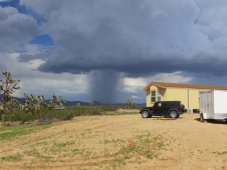Certainly looks like a enviable system to have with the exception of the SolArk (it being only 5kW at 240v split phase). I hope your wiring for your home is also well thought out. A system is only as strong as the weakest component.
The house was brand new when we bought it and It's not a "tiny" home, but it is a pretty small one (678sf). It's a
single-wide manufactured home and we did select certain construction options when we ordered it. 2x6 walls and more robust insulation in the roof, and a 200amp load center (for it's spacing ability) were the 2 most important ones on my list. The kitchen is served electrically by both legs and we arranged our electric devices accordingly ( but we typically only use only one appliance at a time anyway).
I did size this system with our needs and a budget in mind. And yes, because of it's size there's only so much to expect out of this systems capabilities. So we always mindful of that and do consider time of day, and PV and storage available when using power.
My heaviest appliances: Air fryer 1600W. Toaster 500W-1400W, Microwave 600W-1600W
Almost all appliances of this type are "on/off operation" appliances, and as you know these: switch from
full power to off for all settings based on thermostat operation. And
almost all microwave ovens use this same method for all power settings except when set at 100%. One exception to this is the
Panasonic inverter microwave. We use the
Panasonic inverter microwave which is one of the only microwave brands that actually
does use "less power" on lower settings (rather than cycle full-on/full-off). and for solar, this is a great microwave - but you normally can't (for the starting surge) run it off a 120v 15amp single phase generator outlet - that's a bit much for the 3500w generator that I had at the time. Long before I even thought about solar, I used Panasonic because I can cook with it on lower and slower setting and cook more thoroughly without burning the edges of the food. (I like a crisp plastic edge on macaroni and cheese, but from a real oven bake,...not the microwave. LOL)
I use a "kill-a-watt" toy (I bought at Harbor Freight to check the basic load of appliances like that.
The stove is gas and we don't really use the oven ( haven't yet) and will probably only use that,- one or two times a year like Thanksgiving. What most people don't realize is that a newer gas stove/oven with electric igniter will consume (in my case ) 600w constantly to insure safe operation of the ovens burners. I avoid those mistakes by ignoring the yellow "dummy" cards on the appliance at the stores and read the UL tags where the power feeds into the device...and the "kill-a-watt" toy is very useful to see the real deal on that, especially if the appliance draws a variable load under different conditions.
The water heater is some-what a problem. It's 240v, single element, 3600W. ( I just heard you fall back in your chair on that one, and for good reason while I'm using a system spec'd at 5kW). During the construction I was discussing options with the dealer and when we talked out this home being installed off-grid and using solar,- we set aside the heating and A/C system. But the water heater was already installed. I said leave it and I'll deal with it later. So for the last 3 months I've actually only used it for about one hour each day ( @ solar noon) when I have over 2000W PV available...so that I'm not pulling so hard off the batteries (I'm very sensitive to that). But I have a 1500W 240v element on order and I'm going to continue to operate the heater at the same time each day ( modified around solar noon). I have an outdoor solar heater design in my plan with a small re-circ pump that I will retro into this heater as a boost.
Wiring:
I won't know the
difference in cost. I don't even look or care, I wont use #14 for anything -
I use only #12 when running 120v lights or outlets. All that's left for me to put is another light in the powerhouse, and a circuit in the water house when I build it. (and I don't need anything else installed in the house). The mini-spits are both 120v and spec'd for #14, but I'm not having it...I used #12 anyway.
Heating and A/C: ( Two, 120V units, I wired these on
opposite legs)
The main open living area is @500sft and served by a single 12,000 BTU mini-split heat pump A/C, and normally keeps the whole house comfortable. 400W-1600W depending on setting and how close the ambient temp is to that setting.
The bedroom is served by a 9,000BTU mini-split heat-pump A/C and we use it rarely. 400W-1200W depending on setting and how close the ambient temp is to that setting.
If we go out in town and don't leave the main unit running, the house might be too cold or too hot when we get back....in the daytime it's not a problem to run both units at the same time - the load balances nicely. But I would only run it that way for a short period of time just to catch up, and when there's good PV and don't expect to have anything else running ( I'll have the water heater off, and not be cooking)
At night: It does takes
more from storage to heat the house the winter, than it does to
cool the house in the summer.
We can benefit from more storage in the winter (for that reason), but so far we're doing fine with this setup (12kW storage) and the Simpli-Phi batteries are still @$2500 each. I'm not in a hurry for that, I can wear socks to bed. LOL
Auto-Transformer:
Is most likely next on my options list. Although I'm moving to a 240v jet pump (for now) I'm probably better of getting a transformer as insurance that I can be better suited for other equipment that the Sol-Ark may struggle with, like a washing machine or other inductive motors, etc.
My Evaluation:
With the help of many people, including you, it's clear for me to understand that this size and type of inverter is not completely suitable for certain types of well pumps, motors...etc. And for that reason, I still feel that my evaluation regarding the (dealer) presentation of this system as a "complete off-grid solution" is lacking without the indication of such necessary add-ons that I find to be either necessary or critical or "true" off-grid application. The recommended kit should be listed with the transformer included or as an optional component ( and the reason why). And the same goes for the remote monitoring feature ability, and firmware update function (that do not work off-grid). If I was evaluating this hybrid inverter in an Grid connected configuration, I'm sure I would be giving it a full 5 stars, because I think it's a really awesome inverter, and the limitations found in my off-grid install....would be non-existent.
I'm very grateful for all the responses here on this thread, including all the mentions and suggestions for my neighbors well. All of this will help lead us to a very well configured solution on his system.







